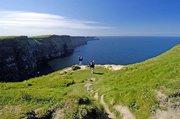Biome
|
|
Biomes may be divided into:
- Terrestrial (also called continental) biomes and
- Aquatic biomes.
Often, a type of biome in a particular area is given a local name. For example, a Temperate grassland or shrubland biome is known as steppe in central Asia, savanna or veld in southern Africa, prairie in North America, pampa in South America and outback in Australia.
| Contents |
Latitude Classification
Latitude is a major factor defining biomes. There is a good correlation between the distribution of climates with latitude, and homogenous vegetation bands. Another major factor is humidity. This can be illustrated by the fact that biodiversity increases away from the poles towards the equator, and increases with humidity.
The most widely used classification of biomes is related to latitude (or temperature zoning) and humidity :
Arctic or Subarctic area
Subarctic and Boreal area
Temperate cold
Temperate warm or sub-tropical
Subtropical coniferous forests
- Mediterranean forests, woodlands, and shrub, Temperate grasslands, savannas, and shrublands
- Temperate deserts and xeric shrublands
Tropical
Aquatic
- continental shelf
- littoral
- riparian
- pond
- lake
- coral reef
- kelp forest
- pack ice
- hydrothermal vents
- cold seeps
- benthic zone
- pelagic zone
Altitude and Latitude Classification
Another system of classification takes into account altitude and humidity, ignoring temperature as a factor. This classification is used to define the Global 200 list of ecoregions identified by the World Wildlife Fund (WWF) as priorities for conservation.
This classification gives the following terrestrial biomes :
- Tundra
- Boreal forests/taiga
- Temperate coniferous forests
- Temperate broadleaf and mixed forests
- Temperate grasslands, savannas, and shrublands
- Mediterranean forests, woodlands, and shrub
- Tropical and subtropical coniferous forests
- Tropical and subtropical moist broadleaf forests
- Tropical and subtropical dry broadleaf forests
- Tropical and subtropical grasslands, savannas, and shrublands
- Deserts and xeric shrublands
- Mangrove
- Flooded grasslands and savannas
- Montane grasslands and shrublands
Biome Picture Gallery
- Pictures of Biomes and Habitats (http://classroomclipart.com/cgi-bin/kids/imageFolio.cgi?direct=Habitats)
- Pictures of Animals (http://classroomclipart.com/cgi-bin/kids/imageFolio.cgi?direct=Animals)
- Animal Clipart (http://classroomclipart.com/cgi-bin/kids/imageFolio.cgi?direct=Clipart/Animals)
Student Resources
Nature Jigsaw Puzzles (http://www.crea-soft.com/online-jigsaw-puzzle/puzzles-category-4.html)
Ecosystems and Biomes (http://www.quia.com/jg/279041.html)
Teacher Resources and Lesson Plans
Biome Lesson Plans (http://lessonplancentral.com/lessons/Science/Earth_Science/Biomes/index.htm)
See also
External links
- WWF article about the Global 200 classification of habitats (http://www.panda.org/about_wwf/where_we_work/ecoregions/global200/pages/terra.htm)



